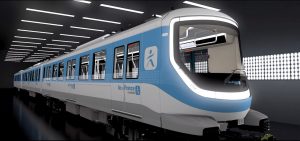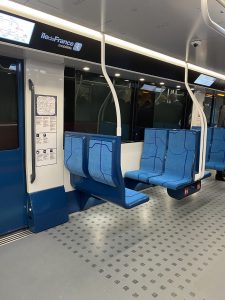 Valérie Pécresse, the President of Île-de-France Mobilités, Thierry Dallard, the Chairman of the Management Board of the Société du Grand Paris, and Henri Poupart-Lafarge, the CEO of Alstom have unveiled the Grand Paris Express train design on October 2, 2020.
Valérie Pécresse, the President of Île-de-France Mobilités, Thierry Dallard, the Chairman of the Management Board of the Société du Grand Paris, and Henri Poupart-Lafarge, the CEO of Alstom have unveiled the Grand Paris Express train design on October 2, 2020.
The design of the metro trains which will operate the future 15, 16 and 17 lines of Grand Paris Express was presented during the inauguration of the exhibition Les lignes du design (Design Lines) which opens at the Fabrique du Métro where visitors will be able to see a model of the future metro.
The three lines will be equipped with state-of-the-art driverless automatic metros developed from solutions from Alstom’s Metropolis range. These metros will guarantee the highest levels of availability, reliability and safety expected by passengers.
The 2.8m-wide trains will have a capacity of 500 passengers in its three-car version and around 1,000 passengers in the six-car version.
The trains will be able to run at a top speed of 110 km/h, with a commercial speed of 55 – 65 km/h. The automatic train operation will ensure travel comfort, with acceleration and braking controlled by automated driving systems combined with an efficient suspension system.
With very wide interior circulation and a variety of grip fixtures, passengers can move around easily and choose the space that suits them. The design of the front end offers passengers a new comfort zone and a panoramic view thanks to a very wide windscreen, a panoramic console, and seating on both sides.
The seats are comfortable with high backrests, wide legroom, isolating armrests, a transversal layout with solo seats and face-to-face duos as well as a longitudinal layout with bench-style seats. This provides passengers to circulate on board the train and enhances the sensation of fluidity and space. Standing travel is also more comfortable with ischiatic supports at the rear of the seats and in the mixed areas, ergonomic hand holds, and circulation areas treated like travel spaces.
The trains will be adapted to the passengers with reduced mobility and for people with children in pushchairs. Each train will have two zones dedicated to wheelchair users and mixed spaces in each car. The priority seats are numerous and easy to identify by their specific colour.
The journey is also pleasant with the sensation of an enlarged space, thanks to clean-cut shapes associated with light colours, and lighting resembling natural light which varies according to the time of day, adjusting to the biological rhythm of the passengers to improve well-being.
 For greater comfort and safety, the metro is accessed underneath reinforced lighting on the platform and on the vehicle threshold. The spaces under the seats are completely unobstructed and equipped with lighting, which reinforces the feeling of security.
For greater comfort and safety, the metro is accessed underneath reinforced lighting on the platform and on the vehicle threshold. The spaces under the seats are completely unobstructed and equipped with lighting, which reinforces the feeling of security.
The future trains will be equipped with modern passenger information systems using screens grouped together in a continuous strip throughout the entire metro. USB sockets for charging phones and tablets are also provided.
Each car is equipped with powerful ventilation, air conditioning and heating systems to ensure thermal comfort in all seasons.
100% electric service braking, a system for recovering the energy generated by braking and the widespread use of LED lighting will help to optimise electricity consumption. The use of electric braking will limit particle emissions. The rolling stock will be more than 98% recyclable.
Particular attention has been paid to optimising the maintenance of the new metro. The on-board diagnostic system will pass on information about the condition of the train equipment and give maintenance staff a complete overview of the condition of the fleet, making it easier to plan corrective and predictive maintenance tasks. These new metros will meet demands to optimise maintenance operations with the aim of reducing maintenance costs over the entire life cycle.
The Grand Paris Express train design was developed in collaboration with Île-de-France Mobilités, Société du Grand Paris, its prime contractor Systra and its design agency RCP Design Global. The concept of the new trains considers the expectations of public transport users, offering a fluid passenger flow, while providing a high comfortable passenger journey.
Share on:



